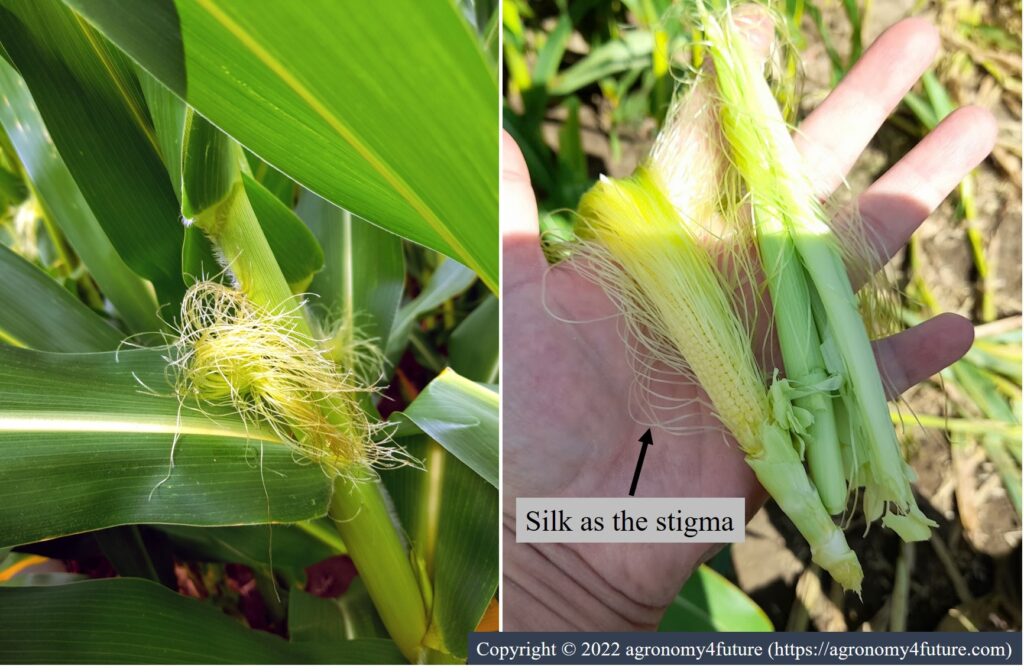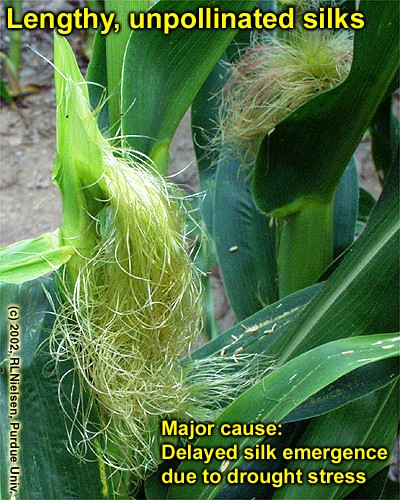Corn Development Stages- R1 (Silking)
In corn, R1 stage (silking) is one of the most critical period to determine yield potential. The emergence of silk is regarded as the initiation of reproductive period. Each ovule (potential kernel) on the ear develops its own silk (as the stigma of the female flower).

Silks initiate to elongate around the V12. It stars from the ovules near the base of the corn cob, and then sequentially developed from base to up. Silking of the tip ovules are lastly developed, indicating the silks from the base of the cob would emerge first from the husk leaves. In other words, the first silks to emerge from the husk leaves are those attached to (potential) kernels near the base of the cob.

When the whole plot have started to silk more than 50%, it is usually regarded as silking stage. Therefore, when we decide silking date, we can not decide based on a single or several plants (particularly it would be important to avoid the plant near border as plants near border are growing faster than inside plants, which means ‘the border effect’).

Flowering initiates when a silk is visible outside the husks. Pollination begins at the base and continue toward the tip. Silks remain active until pollinated. When silking and tasseling are not synchronized timely, silks which are un-pollinated continue to lengthen for ca. a week after emerging from the husks and will perish.
Pollen falls from the tassel to the silks, and fertilize the ovule to produce an embryo (=grain). Potential kernel number will be determined.
One of my interests is when the critical period to determine potential kernel number is. I assume that the reproductive stage of corn would be determined according to this period. If we simply consider flowering time as the initiation of reproductive stage, it seems that we ignore many physiological processes. The below pictures are wheat (at stem elongation: GS 30) and spikelet primordia. It seems it is vegetative stage as only green small leaves are observed, but this period is regarded as the initiation of reproductive stage. After terminal spikelet is determined, spikelet primordia is actively developed, indicating floret (grain) number is determined during the period (GS 30 – GS65). That’s why onset of stem elongation is regarded as reproductive stage.

In corn, kernel row number (girth) and number per row (length) in an ear are two main yield components. Girth determination of the uppermost ear (the ear harvested) begins shortly after the ear shoot is initiated (V5 to V6) and is thought to be complete by growth stage V12, while the potential number of kernels per row (length) is finally determined ca. one week before silk emergence from the husk.

At first I thought reproductive stage of corn might be more earlier than R1 stage as kernel number is usually determined before R1. However, wheat is autogamous crop, while corn is allogamous crop. It means for wheat, pollination would be mostly successful in cleistogamous flower, while corn has one challenge; synchronization between tasseling and silkling. Therefore, kernel number will be finally determined after successful fertilization, indicating that the period to determine final kernel weight would be R1 stage and that’s why initiation of R1 stage would be considered as reproductive stage.
Severe drought stress often delays silk elongation and emergence from the husk leaves. On the other hand, raining at drought condition will more quickly boost silk elongation.

Based on my observation, silking was likely to be delayed due to drought condition, but 2-3 days after raining, all of sudden silking emerged. Important thing is that even though silks emerged, tassels did not emerge (not synchronized for few days), which means it is not the exact R1 stage. Therefore, under the drought stress, we need to more carefully observe plants to follow the correct developmental stage.
